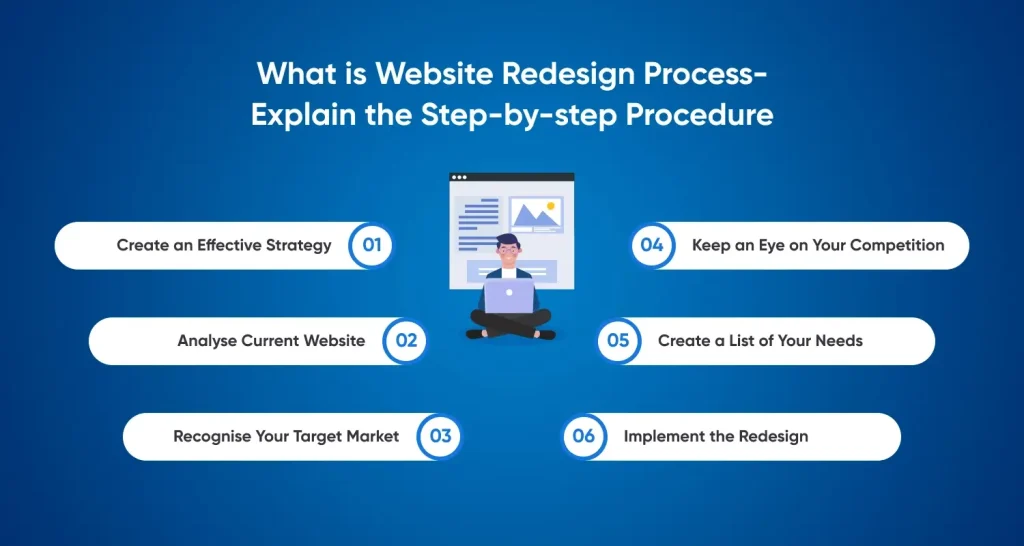Do you run a small business? Are you prepared to advance your internet presence? An engaging website is essential for today’s businesses to draw in and keep clients. Our in-depth website redesign guide will take you step by step through the entire process, whether starting from scratch or giving your current website a facelift. To make it happen, you don’t need to be an expert in web design!
We understand that redesigning a website is a difficult task. We’re here to guide you through the procedure and give you the viewpoints of business leaders from a well-known web development company.
Let’s now begin your road to being the organization’s website redesign expert! We’ll provide priceless information. To make sure your small business website redesign is a roaring success, we’ll share priceless advice and best practices. So let’s start!
What is a Website Redesign?
Redesigning a website is the act of updating an existing one in order to improve its usability, aesthetics, and user experience. It entails strategically updating the website’s design, style, content, and functionality to reflect current market trends and industry best practices.
Why would you think about redesigning your website? You might decide to take this adventure for a number of reasons. Perhaps the design of your current website is old and no longer accurately represents your brand. It might not be responsive, which would make it difficult to use on mobile devices. Or perhaps users have complained about having trouble browsing the website or obtaining information.
To secure an effective outcome while redesigning a website, it’s crucial to use the right resources. A trustworthy website redesign agency or hiring a graphics designer will make all the difference. These experts possess the knowledge to evaluate your current website, comprehend your company’s objectives, and develop a customized redesign approach that is in line with your aims.
The rigorous procedure that goes into redesigning a website begins with gathering needs and doing extensive research. This aids in locating problems, comprehending user behavior, and formulating specific goals for the redesign. A wireframe or prototype is then created as a guide for the structure and design of the new website.
The design phase is completed, and then the development phase starts. The visual aspects are brought to life by skilled engineers and designers working together, combining the most recent web technologies and ensuring flawless functionality across various devices and browsers. Before the website goes online, quality assurance testing is done to work out any faults or problems.
Keep in mind that a website redesign guide involves more than just appearance. It’s about enhancing user engagement, site performance, search engine optimization, and alignment with your company’s goals. It’s a chance to give your online presence fresh vitality and leave a lasting impact on your target market.
5 Reasons to Redesign Your Website
Outdated Design and User Experience: A website with an outdated design may leave visitors with a bad impression and discourage them from returning. You may update the look and feel of your website with the help of a website redesign strategy, giving users a new and exciting experience.
Mobile Responsiveness
Having a responsive website is crucial in today’s mobile-driven environment. You run the risk of losing potential customers if your website is not mobile-friendly. You can add responsive website design services during a website makeover to make sure your site appears and works perfectly on devices with different screen widths.
Poor Conversion Rates
A redesign is necessary if your website isn’t producing the expected conversions or sales. A website redesign can drastically increase your conversion rates by studying user behavior, implementing efficient calls-to-action, and optimizing landing pages.
Search Engine Optimization (SEO)
In order to retain a strong online presence, your website needs to stay up with search engines’ ongoing algorithmic updates. Redesigning a website offers the chance to incorporate SEO best practices, increase page load times, and enhance overall search engine visibility.
Adapting Business Objectives and Branding
Your website should change as your company does. A website redesign enables you to connect your online presence with your current business goals and branding, regardless of whether you’ve changed your branding, increased your product offerings, or changed your target audience.
You may revitalize your online presence, draw more visitors, and experience more success in the digital sphere by taking into account these factors and putting into practice a well-thought-out website redesign strategy.
What is Website Redesign Process – Explain the Step-by-step Procedure

A website redesign guide gives you a plan that needs to be carried out carefully. This section will lay out a process for strategically redesigning a website with an emphasis on user-centric design, effective implementation, and reaching your objectives.
Let’s look at the six crucial steps that will help you on your way to redesign your website.
Step1: Create an Effective Strategy
This website redesign guide involves the steps for a successful redesign. First, articulate your aims and objectives for the website redesign. Establish measurable goals, such as raising lead conversion rates, promoting user engagement, or strengthening SEO performance.
Create a customized website makeover plan that meets your unique business requirements. To develop a seamless user experience that increases conversions and represents your brand identity, think about utilizing UI/UX & design services.
Step 2: Analyse Current Website
Examine your current website carefully to find areas that need to be improved. Examine its design, operation, and navigation to identify any problems and potential improvements.
Based on your study, rank the changes you wish to make in order of importance. Your decision-making during the redesign phase will be guided by this.
Step 3: Recognize Your Target Market
Learn everything you can about the tastes, requirements, and expectations of your target audience. Design your website so that it complements and appeals to your visitors.
Create a user experience that engages and converts by incorporating customer insights. Designing your website in accordance with the tastes of your audience is essential for success, whether you’re displaying art or operating a news blog.
Step 4: Keep an Eye on Your Competition
Research the websites of your industry, specialty, and rivals. Draw inspiration from effective components that go with your brand identity and target market, but avoid outright imitation.
Study the strategies of your rivals and look for chances to set yourself apart using distinctive design features and functionality. To make this process more efficient, use design project management software.
Step 5: Create a List of Your Needs
Make a thorough list of the criteria for your redesign once you have a firm grasp of your target audience and the constraints of your current website. Take into account niche-specific features and other improvements that will increase the usability and overall user experience of your website. To make your concept a reality, work with UI/UX &design services.
Step 6: Implement the Redesign
The last stage is to precisely carry out your website makeover strategy. Make sure there is good communication and adherence to your standards whether you decide to manage the process yourself or by hiring professionals.
Keep a close eye on the development to prevent delays and pointless changes. You may successfully launch your updated website by remaining organized and proactive.
You’ll be prepared to develop an appealing, user-friendly website that promotes engagement, conversions, and company growth by following this step-by-step website redesign process and utilizing website redesign services.

Find Specialists to Redesign Your Website
This website redesign guide includes many factors to take into account while redesigning a website, from front-end programming to UI and UX design. It can be difficult to manage everything on your own, so you should think about working with a reliable website design company. As you look for the ideal experts to redesign your website, bear the following items in mind:
Utilize Review Platforms
Researching review platforms is one technique to identify a trustworthy agency. These platforms offer insightful information on previous customers’ experiences, helping you get a better sense of what it’s like to work with potential service providers. Spend some time reading reviews and sorting through the companies to discover the one that best suits your unique requirements.
Examine Portfolios and Experience
When choosing an agency, pay particular attention to its reviews and portfolio. Choose providers who can provide examples of their work and who have expertise working on projects like yours. This will offer you faith in their skills and guarantee that they are aware of the specifics of your niche and target market.
Consider the Agency’s Process Flow
If you’re considering hiring an agency, it’s important to comprehend their process flow. A clearly defined procedure enables a streamlined redesign while upholding high standards. Ask them about their strategy and make sure it fits your timetable and objectives. You can evaluate their effectiveness and professionalism by doing this.
Inquire about the existence of design systems and aesthetic consistency from prospective agencies. These pre-made alternatives make it easier to quickly create standardized design components and guarantee visual coherence across the entire website. The redesign process can be substantially accelerated by having a design system in place while preserving a unified visual identity.
Knowledge Transfer and Social Engagement
Determine if the business is willing to share its knowledge with others. A quality service will be eager to impart knowledge and offer suggestions outside of the website overhaul. By evaluating their involvement in social activity and industry thought leadership, you can determine their level of knowledge.
Keep in mind that selecting a service provider who not only has experience with website redesign but also performs audits, researches the market, and creates a holistic strategy can be really helpful. They will make sure that your website redesign achieves outstanding outcomes and is in line with your business goals.
List a Few Website Redesign Examples
Here are two real-life examples of well-known businesses that had their websites redesigned:
1. Walmart
To enhance its consumers’ online shopping experiences, one of the biggest retail businesses in the world just completed a massive website revamp. The updated design sought to offer a user-friendly and contemporary interface. Key modifications included:
Improved Navigation and Search: The website has a more user-friendly search feature that makes it easier for consumers to find products. The browsing process was made simpler by the navigation menu’s streamlining and precise categorization.
Personalization and Suggestions: The newly built website included recommendations that were tailored to the browsing and purchasing habits of its customers. By displaying pertinent goods and offers catered to specific preferences, this innovation improved the overall purchasing experience.
Mobile Optimization: Walmart concentrated on making the website mobile-friendly in response to the growing number of mobile shoppers. Customers were able to quickly shop from their smartphones and tablets thanks to the responsive design, which offered a fluid experience across various screen sizes.
2. HubSpot
In order to better match its online appearance with its brand identity and target demographic, HubSpot, a well-known provider of marketing and sales software, redesigned its website. The redesigned website sought to increase user interaction and effectively promote their software products. Key modifications included:
Streamlined Navigation and Information Architecture: HubSpot improved the usability and intuitiveness of its website’s navigation. A new information architecture was created to make it simple to access materials including blog posts, case studies, and instructional material.
Responsive Design and Mobile Optimization: A smooth user experience on smartphones, tablets, and other mobile platforms is made possible by the website’s responsive design and mobile optimization. Visitors may easily access HubSpot’s tools and content from any device thanks to the responsive design.
Visual Design and Branding: To better reflect the HubSpot brand, the website underwent a visual design makeover. Bold colors, legible text, and captivating images were used to create a visually appealing and coherent experience that captured the spirit and ingenuity of the business.
Enhanced Conversion Possibilities: HubSpot carefully positioned conversion possibilities all around the website, including lead capture forms and big call-to-action buttons. This enhanced their inbound marketing approach and aided in lead generation.
You may like this: How to Build a Web App in 6 Steps?
Conclusion
In conclusion, a website redesign is an essential project for companies looking to improve their online presence and accomplish their objectives.
Businesses may build a user-friendly and aesthetically pleasing website that is consistent with their corporate identity, engages their target audience, and promotes conversions by following an effective website redesign guide. Each phase is crucial to the project’s success, from developing a plan to analyzing the present website, comprehending the audience, and putting the redesign into practice. Business organizations can improve their online presence and position themselves for growth and success in the digital world with the aid of website redesign services and a well-executed plan.
Frequently Asked Questions
How to Redesign a Website?
Follow a strategic process while redesigning a website, which includes creating a website redesign guide, evaluating the present website, determining the target audience, creating a list of criteria, and putting the redesign into action.
What Are the Phases of a Website Redesign?
Planning and strategy, content and design development, website development, testing and quality assurance, and launch and post-launch activities are the typical phases of a website makeover.
How Much Does It Cost to Have Someone Redesign a Website?
Redesigning a website can cost a variety of amounts, based on the project’s complexity, the extent of the work, and the professional involvement. For a personalized quote, it is better to speak with website redesign services.
How Long Does It Take To Redesign a Website?
The size and complexity of the project determine the timeline for website makeover. It may take a few weeks to several months, depending on the size of the modifications, how the information is moved, and how quickly they are approved. A website redesign company may be able to give a more precise estimate after discussing schedules.







